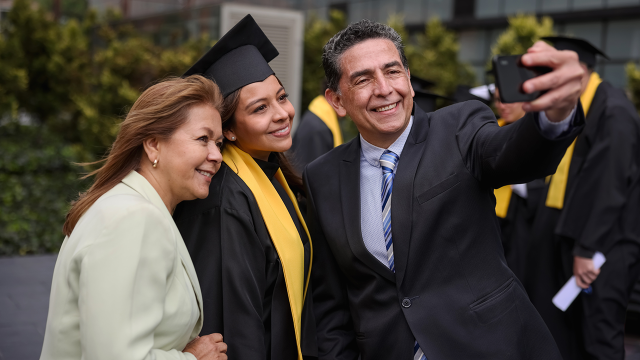
In 2021, nearly 2.5 million Latinos in the United States held advanced degrees such as master’s degrees or doctorates. This represented a huge increase over 2000, when 710,000 Latinos held advanced degrees. The shift reflects Latinos’ broader increase in postsecondary enrollment and rising educational attainment.
Despite the large increase in the number of Latinos with advanced degrees, they accounted for just 8% of all advanced degree holders in the U.S. in 2021. This was far below their 19% share of the overall U.S. population, according to a Pew Research Center analysis of Census Bureau data.
Pew Research Center conducted this analysis to examine the demographic characteristics of Latinos who hold a graduate degree. This analysis draws on data from the 1990 and 2000 decennial censuses and the 2010 and 2021 American Community Surveys (ACS), accessed through the Integrated Public Use Microdata Series (IPUMS) from the University of Minnesota.
While looking at the share of populations with a graduate degree, we examined only individuals 25 and older because formal education is not often completed before age 25. While looking at the overall number of graduate degree holders, there is no age filter applied.
All displayed numbers are rounded. Shares and percent changes are calculated using unrounded numbers. Figures of 100,000 or more are rounded to the nearest 10,000; figures less than 100,000 are rounded to the nearest 5,000.
Here are some facts about Latinos who hold graduate degrees:
Among Latinos ages 25 and older, 7% held a graduate degree as of 2021. This was up from 4% in 2000, but still only half the share among all Americans ages 25 and up (14%).
U.S.-born Hispanics 25 and older were more likely than foreign-born Hispanics to have a graduate degree in 2021 (8% vs. 5%).
Overall, U.S.-born Hispanics have more formal education than Hispanic immigrants. In 2021, a majority of U.S.-born Hispanics 25 and older (56%) had at least some college experience, compared with only 31% of foreign-born Hispanics.
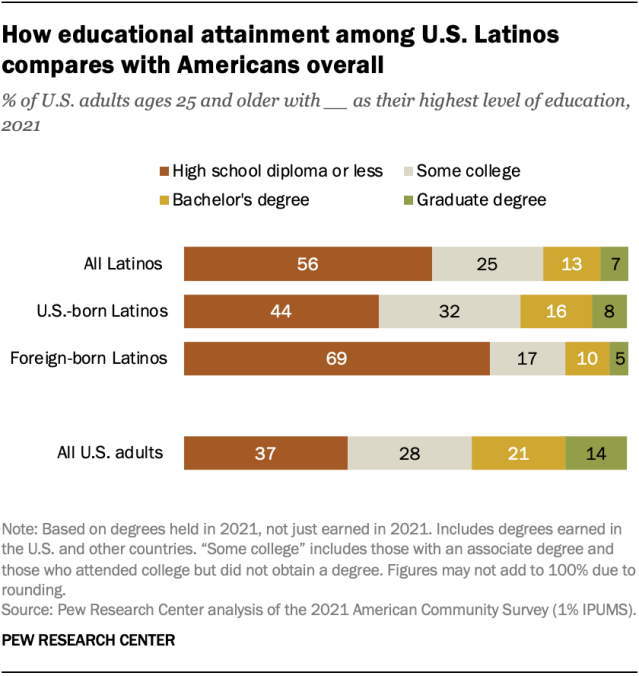
Among Latinos who hold a graduate degree, most hold a master’s as their highest level of education. Among the nearly 2.5 million Latinos who had earned an advanced degree as of 2021 (either in the U.S. or elsewhere), 1.8 million – or 72% – held a master’s degree as their highest degree. These included degrees such as Master of Arts, Master of Science, Master of Social Work and Master of Business Administration.
An additional 440,000 Latinos with an advanced degree, or 18%, had a professional degree beyond a bachelor’s degree as their highest level of education. These included degrees such as Doctor of Medicine, Doctor of Dental Surgery, Doctor of Veterinary Medicine and Juris Doctor (law). Overall, Latinos accounted for 8% of professional degree holders in the U.S. in 2021.
Another 250,000 Latinos with advanced degrees, or 10%, had a doctoral degree, such as a Ph.D. or Ed.D.
Among all Americans, 72% of those with a graduate degree have a master’s degree as their highest level of education, while 17% have a professional degree and 12% have a doctorate.
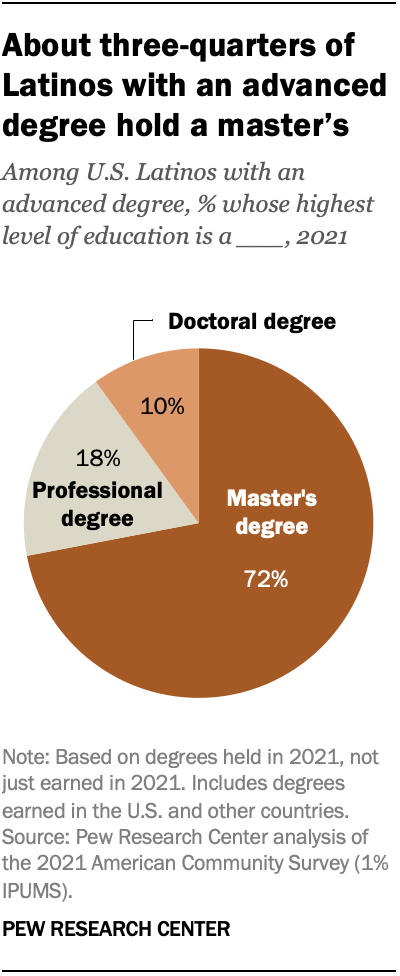
Hispanic Americans have seen the fastest growth in advanced degrees of any major racial or ethnic group. That includes a 291% increase in the number of Hispanic women holding an advanced degree and a 199% increase in that number for Hispanic men between 2000 and 2021. By comparison, there has been slower growth in graduate degrees among White, Black and Asian Americans.
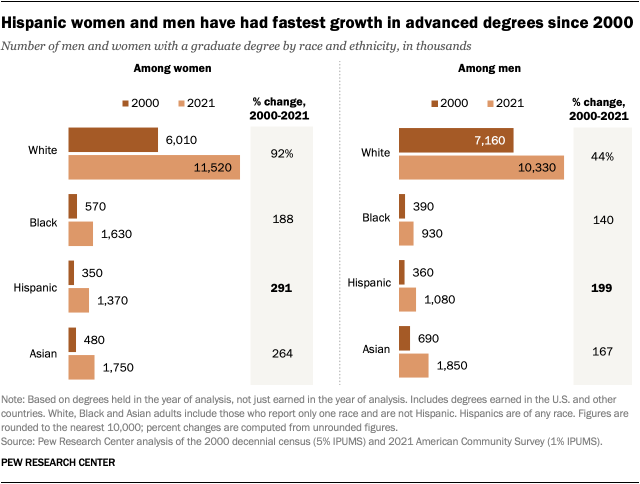
Women have fueled the growing number of Hispanics with graduate degrees. Between 1990 and 2021, the number of Hispanic women with an advanced degree increased by more than a million. The number of Hispanic men with an advanced degree also grew rapidly, though the gain was smaller – about 860,000.
In 1990, about 60,000 fewer Hispanic women than Hispanic men had an advanced degree. A decade later, that gender gap was almost closed. By 2010, women outnumbered men among Hispanics with such degrees. And as of 2021, about 290,000 more Hispanic women than men held a graduate degree.
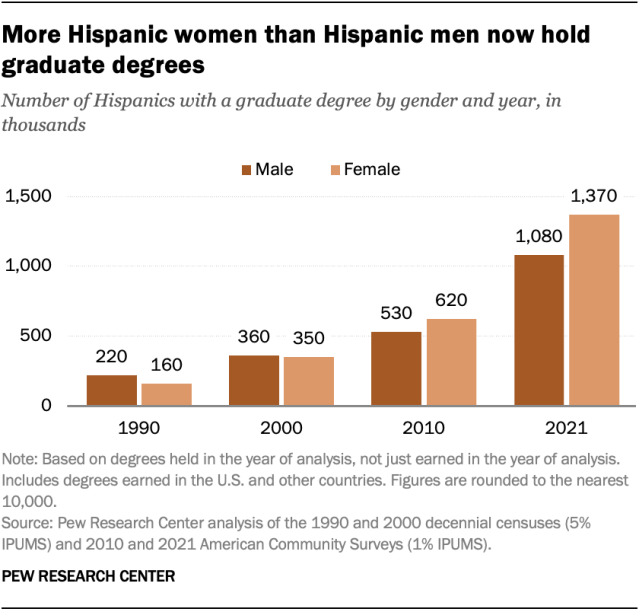
Most Latinos with graduate degrees are U.S. born, but immigrants account for more than a third of the total.
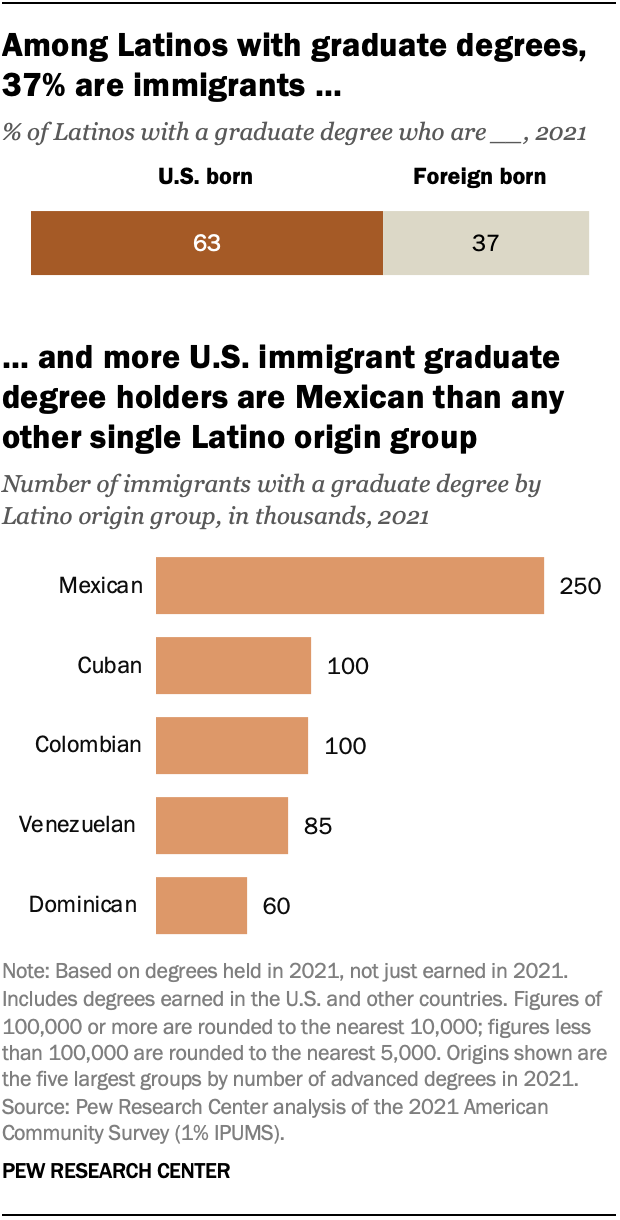
Mexicans are the largest group of immigrant Latinos with graduate degrees, numbering about 250,000 in 2021. They are followed by Cubans, Colombians, Venezuelans and Dominicans.
Venezuelans are the most highly educated of Latino immigrant origin groups. In 2021, 22% of Venezuelan immigrants ages 25 and older had a graduate degree. An additional 36% of Venezuelans held a bachelor’s degree.
Among Latino immigrants with an advanced degree, about 110,00 have a doctorate as their highest level of education (12% of advanced degrees among Latino immigrants) and 200,000 (22%) have a professional degree beyond a bachelor’s. (It’s not clear how many Latino immigrants have earned their degrees outside the U.S.)
These doctorate and professional degree shares are slightly higher for immigrants than U.S.-born Latinos with graduate degrees. U.S.-born Latinos who hold doctoral and professional degrees make up 9% and 15%, respectively, of U.S.-born Latinos with advanced degrees.
Nearly half of all Hispanics with graduate degrees (48%) live in 10 metro areas. In fact, more than 500,000 Latinos with graduate degrees live in just two metro areas: New York (280,000) and Miami (230,000).
Notably, the list of metro areas with the most Latino graduate degree holders differs from the top 10 metro areas by Latino population overall. For example, San Francisco and Washington, D.C., are on the list of top metro areas for Latinos with graduate degrees, but not for Latinos overall. Both cities are hubs for jobs that may require advanced education, such as in technology or policy.


